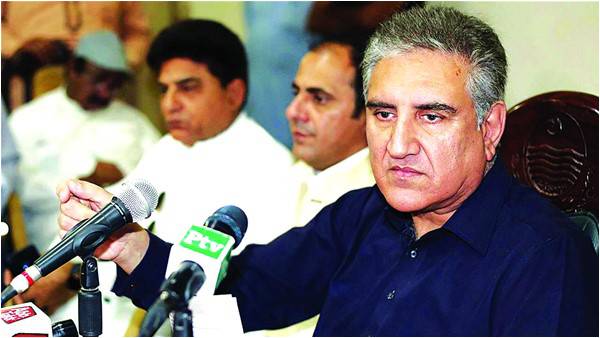
Active military engagement between Pakistan and India in the aftermath of the Pulwama incident took place for merely two days, but the two sides are continuing their battle of narratives, which will have a lasting impact than the actual events.
A few days ago, Foreign Minister Shah Mahmood Qureshi cautioned about the possibility of another act of aggression by India. There is no denying that India, being a rival, will continue to pose a threat to Pakistani security. What many do not realise is that in this fog of confrontational events, a bruising battle of narratives is going on.
For many years India has, with great success, perpetuated the narrative that Pakistan sponsors terrorism. The uprising in Indian-administered Kashmir is also equated with terrorism. It was for this reason that when in Pulwama a Kashmiri young man attacked Indian security forces on February 14, 2019, the script of terrorism was once again parroted with such intensity that it even blinded many in the international arena to the subsequent Indian aggression against Pakistan on February 26 and 27. A reminder of this is important, because we need to keep sight of the fact that we began as the weaker side in this fight of the narratives in this recent chain of events.
The Indian narrative of the events of February 26-27, is that Pakistan was “punished” for its “support for militancy”; that India maintained “dominance” and even “compelled” Pakistan to return its captured pilot Wing Commander Abhinandan “unharmed;” Pakistan was “too weak” to defend itself; and the world “supports” Indian position.
The Pakistani side is asserting that India is an aggressor and regional bully, whose attempts at redrawing the red lines of conflict and browbeating Pakistan were not only successfully thwarted, but that Pakistan’s right to self-defence was also affirmed. Pakistan, at the same time, by repeatedly offering dialogue for peaceful resolution of outstanding issues is trying to address misperceptions created by its adversaries that it is an irresponsible nuclear armed country.
Foreign Minister Shah Mahmood Qureshi, speaking at a seminar on Strategic Stability in South Asia: Emerging Challenges organised by Center for International Strategic Studies (CISS) said: “The recent belligerence displayed against Pakistan and the assumption that Pakistan could be subject to punitive strikes at will is a clear manifestation of threats to stability in the region.”
On Pakistan’s response, he said: “As a peace-loving country, Pakistan is committed to peaceful and normal relations in its neighbourhood. However, we would also like to make it absolutely clear that we are equally determined to frustrate any attempt to create a so-called new normal.”
This rundown in a way shows the battle lines of this unseen and unfelt, but an ongoing and very important war. Luckily Pakistan, despite starting from a weaker standing due to India’s very strong propaganda, has maintained an upper hand in it so far. Be it Indian claims of hitting an alleged terror sanctuary in Pakistan, or scoring an equaliser by shooting down a Pakistani F-16, everything has proven false and could cost Modi and BJP heavily in the elections. It is not Pakistan that is denying that such things did not happen, but the international media, which usually is inclined towards the Indian position, is also saying so. Particularly damning for India’s narrative has been the Foreign Policy Magazine report that said that the United States had counted all F-16s in Pakistani inventory and found none missing. This put the entire Indian narrative into question. ISPR released further evidence by showing pictures of four R-73 missiles seeker heads recovered from the wreckage of Mig-21, which Indians were claiming had shot down the Pakistani fighter. The question for Indians, therefore, is had Abhinandan fired at F-16, how have the four missile seekers been recovered from the debris of the Mig-21 aircraft.
Indians, nevertheless, are not ready to accept this and are going to great lengths to counter it. But, the still photographs put forward by the Indian Air Force to counter the narrative are not good enough to be taken as a conclusive proof to substantiate Indian claims.
The Pakistani plan of action is to project itself as pro-peace. Pakistani moves to accept an Indian suggestion for another round of technical talks on Kartarpur Corridor on April 16, despite the fact that India pulled out of the negotiations on the Kartarpur Agreement scheduled for April 2 at Wagah, and issuance of 2,200 visas to Sikh pilgrims on eve of Bisakhi celebrations are designed to support the objective of presenting Pakistan as desirous of peace in contrast to belligerent India. Lest one forgets, it was Pakistan that took the initiative of sending back its high commissioner to Delhi after things started moving towards de-escalation in the first week of March and carrying on with the timeline of Kartarpur Agreement negotiations, under which the first round of parleys were hosted by India.
However, in this battle of narratives, what is being missed out is the plight of Kashmiris. It is equally important for Pakistan to keep highlighting the sufferings of Kashmiris in the Occupied Valley. Pakistan has a commitment to the Kashmiris to continue supporting their movement by diplomatic and political means.
The fight of narratives will be a protracted one and requires lot of attention, because unlike the past when there were clear battlefield victors and the vanquished, in today’s world it is all about who dominates the narratives. It is, moreover, not just about perceptions, but it also shapes international politics and determines the future course of conflict resolution.
The writer is a senior researcher at Islamabad Policy Institute. She can be reached at mamoona.rubab@ipipk.org
A few days ago, Foreign Minister Shah Mahmood Qureshi cautioned about the possibility of another act of aggression by India. There is no denying that India, being a rival, will continue to pose a threat to Pakistani security. What many do not realise is that in this fog of confrontational events, a bruising battle of narratives is going on.
For many years India has, with great success, perpetuated the narrative that Pakistan sponsors terrorism. The uprising in Indian-administered Kashmir is also equated with terrorism. It was for this reason that when in Pulwama a Kashmiri young man attacked Indian security forces on February 14, 2019, the script of terrorism was once again parroted with such intensity that it even blinded many in the international arena to the subsequent Indian aggression against Pakistan on February 26 and 27. A reminder of this is important, because we need to keep sight of the fact that we began as the weaker side in this fight of the narratives in this recent chain of events.
Particularly damning for India’s narrative has been the Foreign Policy Magazine report that said that the United States had counted all F-16s in Pakistani inventory and found none missing
The Indian narrative of the events of February 26-27, is that Pakistan was “punished” for its “support for militancy”; that India maintained “dominance” and even “compelled” Pakistan to return its captured pilot Wing Commander Abhinandan “unharmed;” Pakistan was “too weak” to defend itself; and the world “supports” Indian position.
The Pakistani side is asserting that India is an aggressor and regional bully, whose attempts at redrawing the red lines of conflict and browbeating Pakistan were not only successfully thwarted, but that Pakistan’s right to self-defence was also affirmed. Pakistan, at the same time, by repeatedly offering dialogue for peaceful resolution of outstanding issues is trying to address misperceptions created by its adversaries that it is an irresponsible nuclear armed country.
Foreign Minister Shah Mahmood Qureshi, speaking at a seminar on Strategic Stability in South Asia: Emerging Challenges organised by Center for International Strategic Studies (CISS) said: “The recent belligerence displayed against Pakistan and the assumption that Pakistan could be subject to punitive strikes at will is a clear manifestation of threats to stability in the region.”
On Pakistan’s response, he said: “As a peace-loving country, Pakistan is committed to peaceful and normal relations in its neighbourhood. However, we would also like to make it absolutely clear that we are equally determined to frustrate any attempt to create a so-called new normal.”
This rundown in a way shows the battle lines of this unseen and unfelt, but an ongoing and very important war. Luckily Pakistan, despite starting from a weaker standing due to India’s very strong propaganda, has maintained an upper hand in it so far. Be it Indian claims of hitting an alleged terror sanctuary in Pakistan, or scoring an equaliser by shooting down a Pakistani F-16, everything has proven false and could cost Modi and BJP heavily in the elections. It is not Pakistan that is denying that such things did not happen, but the international media, which usually is inclined towards the Indian position, is also saying so. Particularly damning for India’s narrative has been the Foreign Policy Magazine report that said that the United States had counted all F-16s in Pakistani inventory and found none missing. This put the entire Indian narrative into question. ISPR released further evidence by showing pictures of four R-73 missiles seeker heads recovered from the wreckage of Mig-21, which Indians were claiming had shot down the Pakistani fighter. The question for Indians, therefore, is had Abhinandan fired at F-16, how have the four missile seekers been recovered from the debris of the Mig-21 aircraft.
Indians, nevertheless, are not ready to accept this and are going to great lengths to counter it. But, the still photographs put forward by the Indian Air Force to counter the narrative are not good enough to be taken as a conclusive proof to substantiate Indian claims.
The Pakistani plan of action is to project itself as pro-peace. Pakistani moves to accept an Indian suggestion for another round of technical talks on Kartarpur Corridor on April 16, despite the fact that India pulled out of the negotiations on the Kartarpur Agreement scheduled for April 2 at Wagah, and issuance of 2,200 visas to Sikh pilgrims on eve of Bisakhi celebrations are designed to support the objective of presenting Pakistan as desirous of peace in contrast to belligerent India. Lest one forgets, it was Pakistan that took the initiative of sending back its high commissioner to Delhi after things started moving towards de-escalation in the first week of March and carrying on with the timeline of Kartarpur Agreement negotiations, under which the first round of parleys were hosted by India.
However, in this battle of narratives, what is being missed out is the plight of Kashmiris. It is equally important for Pakistan to keep highlighting the sufferings of Kashmiris in the Occupied Valley. Pakistan has a commitment to the Kashmiris to continue supporting their movement by diplomatic and political means.
The fight of narratives will be a protracted one and requires lot of attention, because unlike the past when there were clear battlefield victors and the vanquished, in today’s world it is all about who dominates the narratives. It is, moreover, not just about perceptions, but it also shapes international politics and determines the future course of conflict resolution.
The writer is a senior researcher at Islamabad Policy Institute. She can be reached at mamoona.rubab@ipipk.org

